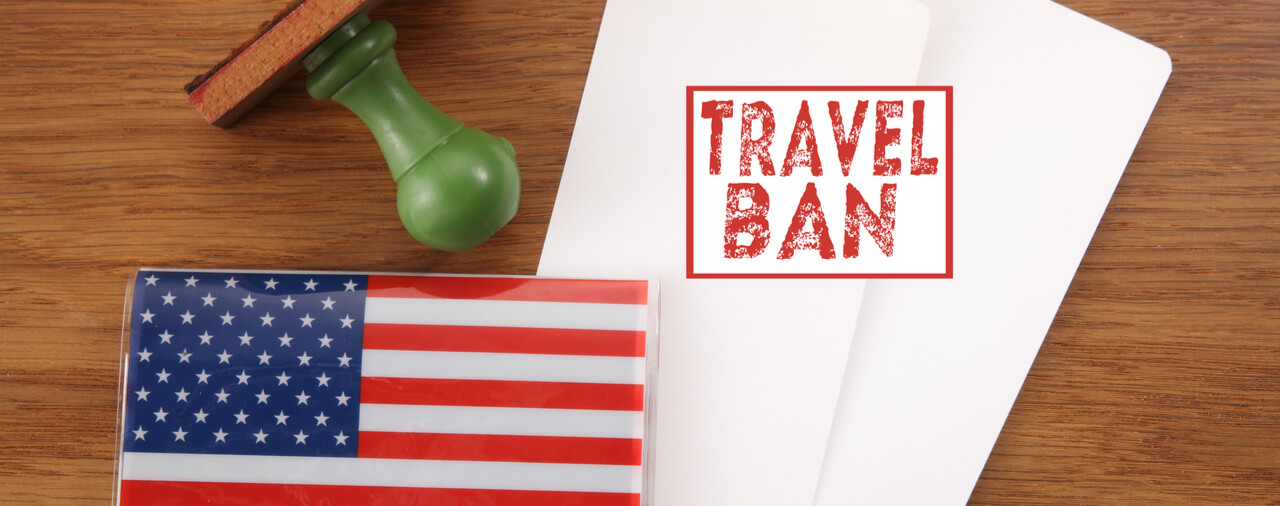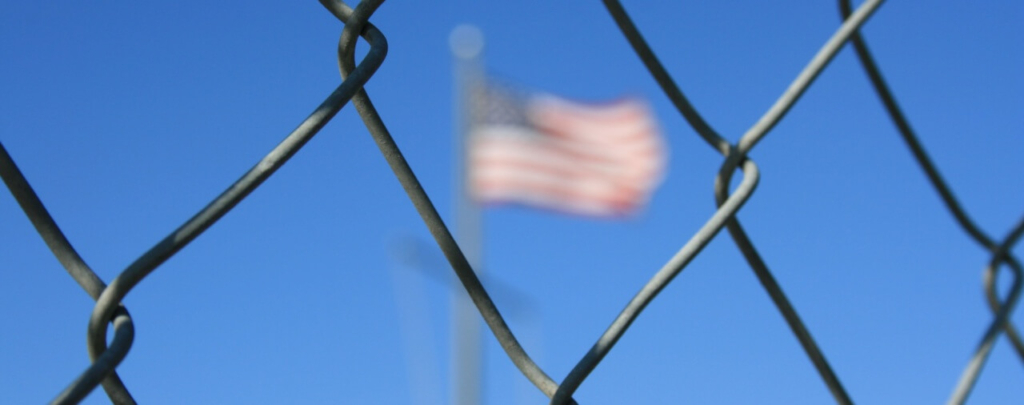Introduction
On April 25, 2018, the Supreme Court of the United States heard oral arguments in Trump v. Hawaii, No. 17-695. Trump v. Hawaii concerns the entry restrictions against nationals of seven countries in President Donald Trump’s September 24, 2017 Presidential Proclamation titled “Enhancing Vetting Capabilities and Processes for Detecting Attempted Entry Into the United States by Terrorists or Other Public-Safety Threats” [PDF version]. These restrictions are colloquially known as the “travel ban.”
In oral arguments, U.S. Solicitor General Noel J. Francisco [see blog] represented the United States Government while Neal K. Kaytal, who served for one year as acting Solicitor General during the administration of former President Barack Obama, presented arguments on behalf of Hawaii and the other respondents.
The Supreme Court is expected to issue a decision in the case by June 2018.
In this article, we will examine how we arrived at the oral arguments in Trump v. Hawaii. In the conclusion of the article, we provide links to our two summaries of the oral arguments.
Please see the text of the oral arguments [PDF version] and listen to the oral arguments below:
To learn about President Trump’s proclamation and all important updates on its implementation and associated litigation, please see our full article on the subject [see article].
Background
On January 27, 2017, President Trump issued his Executive Order 13769, titled “Protecting the Nation from Foreign Terrorist Entry into the United States” [PDF version]. Executive Order 13769 prohibited the entry of nationals from seven countries, and it initially also applied to those who already had visas and to aliens who had been lawfully admitted for permanent residence. After the Executive Order 13769 was stymied in court through injunctions, President Trump superseded it on March 6, 2017, with Executive Order 13780 [PDF version] [see article]. Executive Order 13780 suspended the entry of nationals from six countries for a period of 180 days, but it did not apply to those who already had valid visas, and it also included a waiver provision.
Executive Order 13780 was also enjoined by multiple Federal district courts, and those injunctions were affirmed by the United States Courts of Appeals for the Fourth and Ninth Circuits, in separate decisions. The Supreme Court agreed to take the cause on appeal on June 24, 2017, but in so doing, it substantially narrowed the scope of the standing injunctions, allowing most of the entry restrictions to go into effect [see article]. Notably, Justices Clarence Thomas, Samuel Alito, and Neil Gorsuch took the position in a separate opinion that the Court should have allowed Executive Order 13780 to go into effect in full.
However, before the Supreme Court could hear oral arguments on Executive Order 13780, President Trump replaced it with the Presidential Proclamation at issue in the instant proceedings on September 24, 2017. Instead of proceeding with oral arguments on Executive Order 13780 , the Supreme Court dismissed the challenges as moot and vacated the judgments of the Fourth [see article] and Ninth [see article] Circuits.
The entry restrictions in the September 24 proclamation were subsequently enjoined by two Federal district courts. On December 4, 2017, while appeals of these new injunctions were pending before the Fourth and Ninth Circuits, the Supreme Court lifted the injunctions while the litigation was pending, allowing the entry restrictions to take full effect. In this instance, Justices Ruth Bader Ginsburg and Sonia Sotomayor dissented from the decision, taking the position that they would have allowed the injunctions to remain in place. On December 24, the Ninth Circuit then affirmed an injunction issued by the United States District Court for the District of Hawaii, blocking most of the entry restrictions but staying its order to abide by the Supreme Court’s earlier decision. The Trump Administration appealed from the Ninth Circuit decision, and the Supreme Court granted certiorari (agreed to hear the case). The full Fourth Circuit issued its own decision affirming an injunction issued by the United States District Court for the District of Maryland and staying its decision because the Supreme Court had already granted certiorari in the matter of the appeal from the Ninth Circuit decision [see article].
Issues
In taking the case, the Supreme Court announced that it would consider the following questions:
1. Whether the respondent’s challenge to the President’s suspension of entry of aliens abroad is justiciable.
2. Whether the Proclamation is a lawful exercise of the President’s ability to suspend entry of aliens abroad.
3. Whether the global injunction is impermissibly overbroad.
In addition, the Supreme Court asked for briefing on the issue of whether the Proclamation violates the Establishment Clause of the United States Constitution.
We discussed all of these questions in our post on the Supreme Court’s decision to grant cert on January 19, 2018 [see article].
In the following sections, we will examine how the Justices tackled these important issues in oral arguments, and how the attorneys representing both sides presented their arguments.
Relevant Provisions
As we noted, the issue before the Court was the legality of President Donald Trump’s September 24, 2018 Presidential Proclamation insofar as it restricted the entry of nationals of eight countries [see article].
President Trump relied heavily on section 212(f) of the Immigration and Nationality Act (INA) in implementing the entry restrictions. The statute, in pertinent part, reads as follows:
Whenever the President finds that the entry of any aliens or of any class of aliens into the United States would be detrimental to the interests of the United States, he may by proclamation, and for such period as he shall deem necessary, suspend the entry of all aliens or any class of aliens as immigrants or nonimmigrants, or impose on the entry of aliens any restrictions he may deem appropriate.
To learn about section 212(f), please see our full article on the subject [see article]. We will update our section 212(f) article once the Supreme Court issues a decision in the instant case.
The respondents argued that President Trump contravened the INA by implementing the restrictions in the proclamation. One of the arguments presented was that Congress had considered the issues that the Proclamation was designed to address and had declined to implement entry bans based on nationality. Secondly, the respondents argued that the entry restrictions, based on nationality, violated section 202 of the INA insofar as it prohibits nationality-based discrimination in the allocation of immigrant visas. The statute — section 202(a) — reads in the pertinent part as follows:
[N]o person shall receive any preference or priority or be discriminated against in the issuance of an immigrant visa because of the person’s … nationality, place of birth, or place of residence.
Although not relevant to the arguments, please note that section 202(a) does exempt per-country immigrant visa limits from this proscription.
The Supreme Court also heard argument on whether the entry restrictions violated the Establishment Clause of the First Amendment to the United States Constitution. The Establishment Clause reads as follows:
Congress shall make no law respecting an establishment of religion, or prohibiting the free exercise thereof…
As we will see, the two sides took different positions on whether statements by President Trump imputed religious animus to the entry restrictions and whether the respondents had standing to bring the Establishment Clause claims in the first place.
To counter the respondents’ reliance on statements made by President Trump prior to his taking the oath of office, the Government alluded to the Opinion Clause found in Article II, Section 2, Clause 1 of the United States Constitution. The Opinion Clause reads as follows:
The President … may require the Opinion, in writing, of the principal Officer in each of the executive Departments, upon any Subject relating to the Duties of their respective Offices…
As we will see, Francisco took the position that the Opinion Clause supports the idea that the President’s statements as a private citizen prior to receiving the opinions of his cabinet should not be considered in evaluating the intent of the Proclamation.
The oral arguments also addressed other provisions of law as well as prior Supreme Court decisions in discussing these important issues. We provide context and explanations of these additional points in our distinct articles on the oral arguments.
Structure of Oral Arguments
Solicitor General Noel Francisco, representing the Government, made his case first during oral arguments. Kaytal, representing the respondents, made his case second. After both sides had the opportunity to present their arguments, Francisco was allotted five minutes of rebuttal time. In the following sections, we will examine key points from the oral arguments before discussing what the content and tenor of the arguments may mean regarding the Court’s ultimate decision in the case.
Please see our summaries of the government’s oral arguments [see article] and the oral arguments of Hawaii and the other respondents challenging the legality of the entry restrictions [see article].





